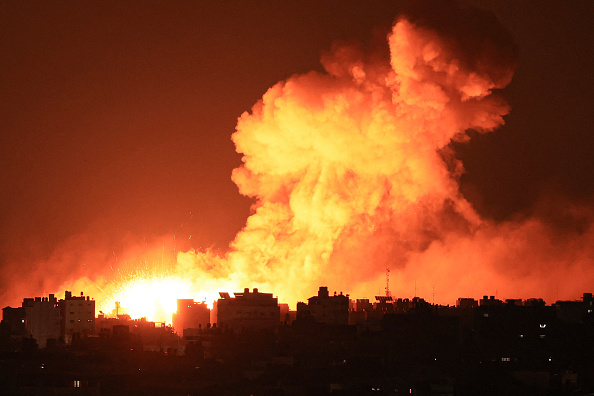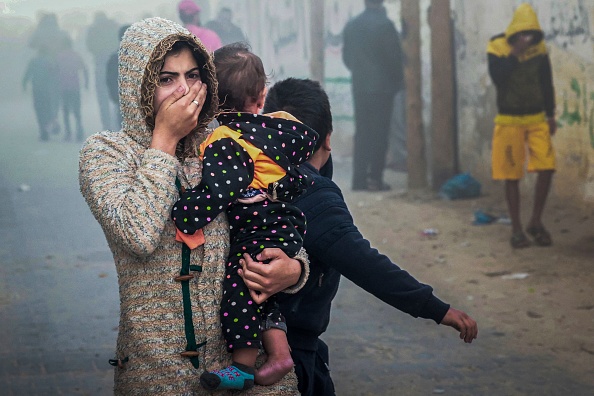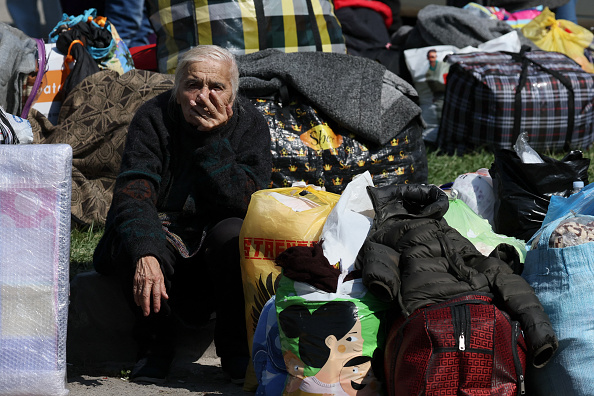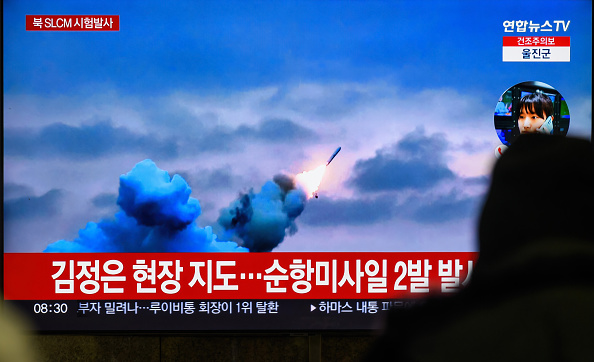A Slaughter of Superlatives

Although we have never been good enough to consistently act in accordance with this insight, in our better moments we know that all human beings are fundamentally equal. Therefore, the victims of mass murderers who are motivated by the will to destroy – “in whole or in part” – specific ethnic groups are also equal. Hence, we must not establish (or tolerate) hierarchies between genocides by singling one of them out as “unique.” Because to do so is to imply that the victims of other genocides were – and are, and, sadly, will be (the way we are going) – in some important manner, impinging on our shared humanity, lesser. And that, for one thing, would be a perverse obverse of the very “logic” genocide perpetrators practice.
In a more concrete sense, a genocide can, of course, have its own special, even unique features: For instance, in terms of the murderers’ motivation (imperialist disdain for the starving “natives” combined with Social Darwinism and a fanatical devotion to “self-regulating markets” in British cases; a fascist ideology centered on racialized antisemitism, in the Nazi German case; a fascist ideology centered on imperialist supremacism and a settler-colonialist land grab in the Zionist Israeli case, and so on). Genocides also diverge regarding the means employed, such as, in alphabetical order, bombing, bullets, creating conditions for epidemics, gas chambers, lethal displacement, machetes, overwork, and starvation. Genocides, finally, differ in terms of size and the chances of survival among their victims. Since, contrary to widespread misunderstandings, genocide is not defined by large numbers and even less by “success” in entirely exterminating a targeted group, but, most of all, by the intention of the mass murderers, survival chances can vary substantially.
The Israeli genocide of the Palestinians that the world is currently witnessing has several such special, concretely unique (at least for now) features. Some of them even qualify as a particular type of superlative, achieving inverted peaks of depravity.
Take the means of the killing: Not the only one, but the most immediate and prominent one has been massive bombing. While often misleadingly described as “indiscriminate,” that term is correct only in a strictly technical sense: According to Gaza’s authorities, two thirds of the bombs Israel has dropped on its Palestinian victims have been “dumb,” i.e. unguided. Even an official assessment from the U.S., complicit in Israel’s genocide, counts nearly half of them as dumb, which, as the former UN war crimes investigator Marc Garlasco has commented, “completely undercuts” any Israeli claims of “minimizing civilian harm.”
Israel’s persistent pattern of driving or luring its victims into “safe zones” and then bombing them there as well also shows that its assault is not “merely” indiscriminate: The relocation orders that Israeli forces issue in this process, are, in the word of the Save the Children charity, a “smokescreen of safety,” leaving the victims “with a ‘choice’ of one death sentence or another.”
Despite perverse arguments to the contrary by Israeli advocates of lawlessness such as Pnina Sharvit Baruch, Israel clearly does not care about the distinction between military targets and civilians or about the principle of proportionality, which, in essence, says that you are permitted to kill some civilians to achieve your military purpose. But you still a) must have a military purpose (the civilians cannot be your target) and b) there has to be a plausible quantitative (yes, it’s that ruthless) relationship between the military importance of your target and the number of civilians you (also) kill to hit it.
Is that a deeply absurd principle bespeaking humanity’s generally benighted condition? Yes, as historian Norman Finkelstein argues. But you should see what happens when it is abandoned with a will. In fact, you can see: Just look at Israel’s attack on Gaza, where nothing less than a war crime – indiscriminate bombing – has started serving as a euphemism (used even by genocide accomplice and U.S. President Joe Biden) to conceal an even greater crime.
For Israel does not “only” fail to at least try to spare civilians. Rather, this is a campaign designed to murder them. It is not indiscriminate, it is genocidally purposeful. The claim to fight military targets – that is, the Palestinian Resistance – largely serves as a pretext, to do something else, namely kill civilians in large numbers to terrorize and drive away the survivors. This is a genocidal campaign to achieve the final result of ethnic cleansing.
It is true that the Palestinians’ extraordinary perseverance and heroic resistance are very likely to frustrate that strategy. Recent statements by Yoav Gallant, Israel’s Minister of Defense and one of its chief perpetrators, betray a search for a “Plan B.” But that makes no difference to the compelling evidence, in word and deed, of the existence of a strategy of ethnic cleansing and, indeed, its popularity in Israel’s deeply and widely disturbed “civil society,” from leaked plans to public statements to opinion polls.
From the beginning of the assault, the Israeli perpetrators and their accomplices, including in academia, have shown no shame speaking about expulsion or “voluntary relocation” in the context of an ongoing genocide. Be it into the Sinai desert, to Lebanon, or even farther away. True to form, they do not care that forced displacement (the application of euphemisms makes no difference) is, of course, also a crime against humanity, as Francesca Albanese, the United Nations special rapporteur on the occupied Palestinian territories, has pointed out.
No wonder then, that this ongoing assault has already produced superlatives of firepower spent. According to Gaza’s authorities, Israel has already used over 45,000 bombs and missiles with a total weight of 65,000 tons. Their combined explosive power is greater than that of the two atomic bombs with which the U.S. exterminated the civilians of the Japanese cities of Hiroshima (the equivalent of 15,000 tons of TNT) and Nagasaki (21,000 tons) at the end of World War II.
The bombs used by Israel, to flatten whole apartment blocks and neighborhoods, have included 2,000-pound monsters that have “a lethal fragmentation area equivalent to about 60 soccer fields.” In one such attack, on the Jabaliya refugee camp, more than 100 civilians were killed. Not that the use of such weapons is infrequent: “In some areas of Gaza, so many of the bombs have been dropped that the multiple overlapping ‘kill radius’ circles cover entire districts.” Overkill – literally.
Sheer mass is not all, however. Israel has added Artificial Intelligence to the mix, deploying a system, blasphemously called “the Gospel,” that generates targets at a rate that even the eager Israeli air force struggles to keep up with. Think of the infamous “Skynet” from the “Terminator” movies. Only it’s real, and it’s used not by evil machines but evil humans, who, of course, have not only written its algorithm but also feed it its data to then execute its instructions: Mass murder in, mass murder out, to paraphrase the data scientists. Israel has found a combination between computer callousness and human ingenuity and cruelty that optimizes slaughter. In Gaza, we are seeing if not the then at least one far too possible future, and it’s genocidal.
In general, Palestinian sources have proven factual and honest, unlike Israeli ones, which have consistently sought to overwhelm the world with massive disinformation, especially atrocity propaganda (with great success in the case of Western governments and media only too eager to believe and spread brazen Israeli lies). But there is no need to rely on Palestinian voices alone to assess the scope of Israel’s holocaust by bombs. Rather a growing multitude of experts – as a matter of fact, an emerging consensus – are corroborating the uniquely destructive and murderous nature of the campaign.
Corey Scher (City University of New York) and Jamon Van Den Hoek (Oregon State University), for instance, well-versed in assessing devastation by natural and human causes (including the war in Ukraine), have found that the intensity of the bombing of Gaza exceeds anything they have seen before. In terms of the extent and the speed of devastation, “nothing … tracks” like what Israel is doing to Gaza.
The non-for-profit watchdog Airwars calculates that the rate at which Israel has clobbered the area and its people “has been about 2½ times as high as the peak of the U.S.-led coalition’s effort to defeat the Islamic State, which at its height fired 5,075 air-to-ground munitions across both Iraq and Syria in one month.” But the scale involved goes beyond recent wars: Military historian and expert in bombing campaigns Robert Pape has predicted that “Gaza will also go down as a place name denoting one of history’s heaviest conventional bombing campaigns.”
What about the effects of this barrage? Superlatives there as well: Michael Lynk, a former UN special rapporteur, has observed that the “scale of Palestinian civilian deaths in such a short period of time appears to be the highest such civilian casualty rate in the 21st century,” as the Washington Post reported on 23 December. On the whole, a detailed Post investigation also confirmed that “Israel has carried out its war in Gaza at a pace and level of devastation that likely exceeds any recent conflict, destroying more buildings, in far less time, than were destroyed during the Syrian regime’s battle for Aleppo from 2013 to 2016 and the U.S.-led campaign to defeat the Islamic State in Mosul, Iraq, and Raqqa, Syria, in 2017.”
In terms of human suffering, the results of this razing of Gaza, one of the most densely populated areas in the world, are literally immeasurable. For an outsider, there is no way to truly grasp or share, whether by figures or words, the experience of the murdered, the maimed, the displaced, the starving, the terrorized, their families and friends. The despair of those subjected not “only” to a genocide, but to the spectacle of a world abandoning them, or even helping the murderers, is also beyond words. Those who survive will never forget.
But we can sketch the bare outlines of the horror: As of 6 January 2023, Gaza’s Health Ministry has reported a total of over 22,700 Palestinians (almost one out of every hundred pre-assault Gazans) and almost 58,200 injured. Those murdered include almost 10,000 children and nearly 7,000 women, in other words, the preponderant majority. Add over 7,000 missing (in Gaza alone, that is; the West Bank is undergoing its own wave of violence, smaller in scope but vicious, too). With many still buried under the rubble of their former homes and whole families wiped out, a full count is impossible: We must assume that these are conservative figures. Even on their basis, the overall picture is devastating: As Euro-Med Monitor has reported as of 5 January, 4 percent of Gaza’s population were dead, missing, or injured, while 70 percent of infrastructure was destroyed.
Israel has displayed special efficiency in the rapid murder of children and women. Indeed, preliminary UN figures “show that Israeli forces have killed approximately twice as many women and children in two months in Gaza as Russian forces have killed in Ukraine in nearly two years.” But Israel is achieving superlatives also in killing by profession: As of 3 January, according to the Committee to Protect Journalists (CPJ) and the International Federation of Journalists (IFJ), 80 Palestinian journalists have been killed (and, of course, as is Israeli habit, often their families have not been spared either).

As of 1 January, 142 UN staff, working for the United Nations Relief and Works Agency for Palestine (UNRWA) were dead as well. Even by early November, when Israel had killed “only” 88 UN staff, this was already, according to the Guardian, “the deadliest ever” conflict for United Nations personnel. Aid workers from other organizations have also lost their lives. Israel’s systematic destruction of healthcare facilities – in turn, only a part of a general laying waste of Gaza’s vital infrastructures – has come with the decimation of healthcare workers. Two months ago, their death toll stood at 150. As of 4 January, it reached 374. And counting, and dying, and killing.
Not everyone falls victim to bombs (and, of course, other arms, such as tank shells and bullets, play their role as well, with Israeli forces sniping and massacring civilians at close range, too). As in many genocides, the perpetrators show a lethal pragmatism, employing whatever is at hand and yields results. From the beginning of the attack, Gaza has been under a savage siege, cutting off or severely restricting food, water, power, medication, fuel, internet access, and telecommunications. This war crime and crime against humanity has come on top of 16 years of blockade, in which Israel has not only been “mowing the lawn” regularly (that is, massacring Gazans) but also “keeping Gaza on a diet,” to use the cynical terminology of the killers and tormenters. Call it the strategy of starving the already deprived if you wish: The siege itself is yet another tool of the genocide.
And the starvation, too, is achieving superlative results. According to a UN report of 21 December 2023, not only have 85 percent of Gaza’s surviving population been displaced (often more than once), but 90 percent – over 2 million victims – are suffering “acute food insecurity.” That means that they have been classified, in a painstakingly balanced and well-verified procedure involving multiple agencies and experts, as at “Integrated Phase Classification” (IPC) level 3 (Crisis) or worse. Over 40 percent (939,000) were at level 4 (Emergency) and 15 percent at 5 (Catastrophe). That, the report observes, “is the highest share of people facing high levels of acute food insecurity that this type of classification has ever produced for any given area or country.” The IPC system was initially developed for Somalia in 2004.
Like so many other observers, Arif Husain, the chief economist of the UN World Food Program has met a new dimension of calamity: After two decades of service involving multiple conflict and crisis zones, the Israeli impact on Gaza appears to him “unprecedented” in terms of “magnitude,” “severity” and “the speed at which this is happening.” What can only be described as Israel’s hunger plan for Gaza is setting records already.
We could add more superlatives of depravity in the, as it were, on-the-ground execution of this crime by Israel and its accomplices, most of all in the U.S. and the EU. But there is another sphere in which the Gaza Genocide is setting new standards: Its pro-active shamelessness. It is as if we are witnessing an exercise in signaling how “genocide-positive” Israel and its Western supporters can be.
As far as the perpetrator society is concerned, even while gesturing to euphemisms and pretexts – such as the legally and ethically absurd claim to “self-defense” – many also relish exhibiting their true intentions in public. Often, it is not even an extra-crude nudge and wink, as used by Israeli prime minister and genocide leader Benjamin Netanyahu when referring to “Amalek” (who were exterminated). All too many calls to murder, torture, and annihilate leave nothing to the imagination. As a group of Israeli critics has noted, “explicit calls to commit horrific crimes against the citizens of Gaza began [on October 7] and have since become a legitimate and normal part of the Israeli discourse.” It is fine, even welcome to appear in Israeli good society calling “for destruction; for ethnic cleansing; for executions of prisoners; to drop an atomic bomb; to ‘Nakba 2’; to starve; to create a deliberate humanitarian crisis and to use epidemics as a means of military pressure.” As South Africa has detailed in its complaint to the International Court of Justice, this is a genocide with extraordinarily talkative perpetrators, making it impossible to miss their intention to commit mass murder.
Like Israel’s immense physical violence, which is entirely dependent on Western support in the shape of arms, ammunition, diplomatic cover and military deterrence (keeping other states from intervening to stop Israel and protect its Palestinian victims), this outburst of verbal brutality makes no real dent on the West’s elites’ – in politics, the media, business, think tanks, and much of academia – steadfast backing for Israel.
That, too, is special: While various Western powers have committed genocides – indeed, settler-colonies, such as the U.S. are founded on it – we have not yet seen a genocide committed in broad and global public daylight, watched close-up in real time via traditional and social media, proudly announced and boasted about by the perpetrators, and so massively and obstinately supported by a West that cannot stop claiming “value” superiority. This is why, for psychologist and Holocaust survivor Gabor Mate, this is “the worst thing” he has seen in his whole life.
The last century was so marred by genocidal violence that it may be hard to imagine, but, while the first quarter of the twenty-first century has not yet passed, we are already adding something new and special to the historical record. Not in terms of sheer numbers. Those complacent, callous, and shortsighted enough may take an abject kind of solace from that fact. Yet for those who still have a functioning mind and conscience, Israel’s Gaza Genocide already stands out as producing peculiar peaks of devastation as well as shamelessness among the many accomplices no less than the proud perpetrators. There is something “unique” about it. For now. For it is also likely to set new, horrifying standards of what we will be conditioned to accept as “normal” – or, at least, as something we cannot resist.
Tarik Cyril Amar (@TarikCyrilAmar), is an historian from Germany currently at Koç University, Istanbul, and author of The Paradox of Ukrainian Lviv. A Borderland City between Stalinists, Nazis, and Nationalists.



